Environmental enrichment describes the provision of physical and social opportunities to promote chicken behaviour that is important, valuable, and specific to them. It encourages and allows chickens to do things that matter to them, resulting in positive experiences based on their individual interests, which underpins good animal welfare.
Animals who can express species‐specific behaviours, and have choice, control, and problem-solving opportunities are more likely to experience good welfare. Because they are physically and mentally challenged in positive ways, they are less likely to feel frustrated or display abnormal behaviours. Chickens who are not having positive experiences and/or are having negative experiences, may display a range of abnormal or irrelevant behaviours, including:
- Escape behaviour
- Feather picking directed at themselves
- Redirected pecking i.e., pecking at other chickens or objects
- Stereotypic behaviour (repetitive behaviour that serves no purpose) e.g., pacing
- Feather-damaging behaviour
- Abnormal vocalisations – e.g., excessive crowing
Environmental enrichment that promotes species‐specific behavioural interactions (with the environment, with other animals, and with people) is both a way to provide the opportunities for your chickens to experience good welfare and, to an extent, prevent or treat abnormal behaviours that can arise due to restrictions of their behavioural interactions in the domestic environment.
Normal behaviour
A key concept in environmental enrichment requires is that we know what chickens like to do, also referred to as ‘species‐typical’ information. Then we can select enriching strategies that are behaviourally relevant and physically feasible for the bird. Designing an enrichment plan that is incompatible with the animals’ normal behaviour, physical attributes or their existing environment may not improve their wellbeing and could also cause frustration and potential harm.
So, what is a chicken’s normal daily behaviour?
The type of behaviour exhibited by chickens varies according to their individual interests, the type of environment, the age and sex of the birds, and their reproductive status. Some studies suggest that their preferred habitat (where they display the greatest variety of behaviours) is dirt-based rather than grass, with low sheltering shrubbery (such as acacia scrub) rather than out in the open or amongst large trees (which may be driven by a desire to avoid predators, on the ground or from the air). Much is yet to be learned about what habitat domestic chickens prefer – as opposed to what habitat we would prefer them to experience.
In the wild, jungle fowl (the ancestors of most of our chickens) spend 61% of their time foraging. Foraging behaviours include pecking and scratching at potential food sources, as well as looking for and sampling possible food sources. Providing chickens with a complete feed eliminates the need for foraging to obtain nutrients, but the hens will continue performing this behaviour. If given the space, chickens will cover a lot of ground in a day, foraging for insects, grubs, and plants along the way.
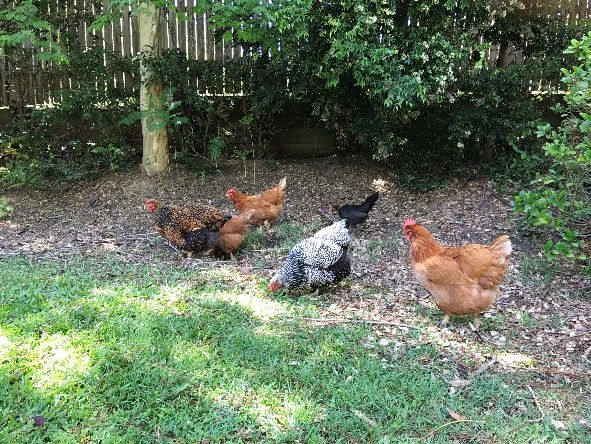
Chickens will also spend a fair amount of time each day grooming and bathing. Feathers are important for insulation and waterproofing (in addition to flight for those birds who can fly). When chickens preen (groom themselves), they run their feathers through their beak. This aligns the feathers so they are comfortable and better able to perform their functions. Birds also need to keep their feathers oiled to prevent them from becoming brittle and to help with insulation and waterproofing. Birds have a single oil gland near the base of the tail, referred to as the preen gland. Birds pinch this gland with their beaks to extract a waxy oil, which they then apply as they pass their feathers through their beaks.
Chickens enjoy a dust or dirt bath and also need to do this for good health. This activity helps to remove parasites, dead skin, and other skin irritants. It also helps prevent the buildup of the oil from preening through the preening process during these baths.
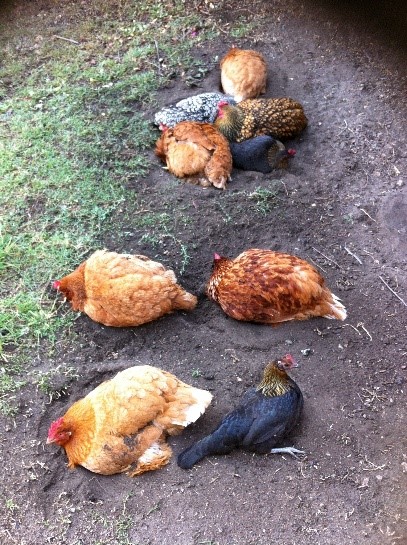
Chickens prefer to perch at night, jumping or flying up to raised perches about half an hour before twilight, with the actual time depending on light intensity. As social animals, they often snuggle together during the night and start spreading out about two hours before sunrise. They fly down from the perch usually about 30 minutes before dawn. After a short spell of grooming and stretching, they begin to call to each other to assemble the flock. There may be some playing activity and socialising before the flock sets out to search for food.
Environmental enrichment
There is a tendency to think that environmental enrichment means just providing some toys. This is only a small part of the process. An enrichment plan should include some or all of the following:
- Foraging enrichment
- Physical enrichment
- Sensory enrichment
- Social enrichment
- Occupational enrichment
Foraging
Foraging is the act of searching for and finding food. As mentioned earlier, wild chickens can spend up to 61% of their day foraging and feeding, most actively in the morning and the evening. Foraging therefore has great social and behavioural importance, but can be one of the most severely constrained classes of behaviour in backyard chickens. Given a choice between foraging or just eating out of a bowl, chickens will always prefer to forage.
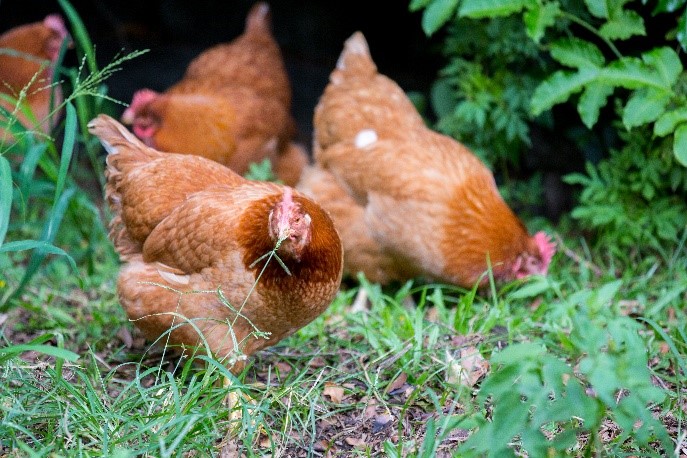
If possible, allow for free-ranging times when you can monitor your chickens or create a “chicken tractor” (a mobile pen that is moved automatically every few hours) to allow the birds to safely move from one area to the next. Other suggestions include:
- Scatter their food around the run and in your yard for your chickens to find as they forage during the day.
- Provide them with ‘snuffle mats’ (rubber-backed mats with loose fabric and hiding places that create the perfect stimulation for your chickens to find their treats. Berries, and seeds can be sprinkled in the mat for your chickens to find.
- If your chicken run does not have grass, then you can grow pasture grasses in trays. When the grass reaches 2-5cm tall, sprinkle in treats and give the tray to your birds. They will forage for the treats, eat the grass, and dig in the dirt which are all normal bird behaviours.
- Plant perennial herbs like mint, thyme, and oregano in planter boxes. Once they are well established, you can place them in your chicken run. Put chicken wire over the boxes so that the birds can get to the plants but not dig in the dirt.
- Leafy greens (e.g., kale, lettuce, Bok choy), hanging from clothes pins or pushed into a baffle cage, will encourage them to stretch and hop up to get the treats, just like they would naturally jump at low-hanging branches.
- Provide a dig box – an enclosed space full of dirt, wooden blocks, or even garden mulch – with food treats hidden amongst the material.
Physical enrichment
Physical enrichment ranges from objects placed in the bird’s environment (such as toys, perches, dust baths, etc.) to the environment as a whole (e.g., the space available for your bird to engage in locomotory behaviours such as flying, running, or foraging). Suggestions include:
- Provide dust baths. If a natural dirt hole does not exist, you can make one using a low-sided kitty litter tray or children’s pool, filled with sand or dirt. The tray needs to be big enough to allow your chickens to get their bodies down in the dirt and enjoy their bath.
- Add stumps, ramps, platforms, and ladders all provide different opportunities to perch and explore. Add and secure branches for perches. Try out swings and more complex furniture (keeping in mind the needs of the individual).
- Cover some overhead areas to provide a sense of safety and shade to more comfortably allow exploration of the living space.
- Add bells throughout their environment for chickens to peck at and listen to their own music! Or add visually stimulating objects, such as mirrors or pinwheels, to spark their curiosity. Ensure these toys are safe and will not break when chickens peck at them.
- Provide treat balls – a ball with holes cut into it and then filled with treats. The treats will roll out as the chickens peck and play with it.
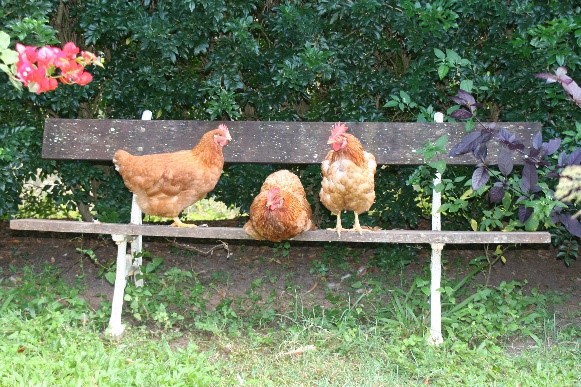
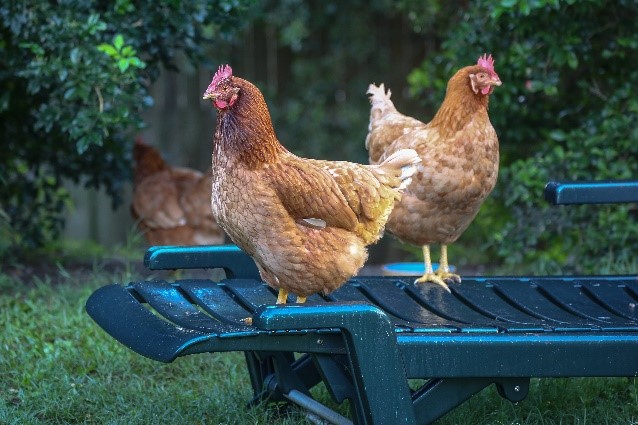
Chickens are smart animals and may become bored when provided with the same enrichment day after day. Incorporate new items and switch up their enrichment schedule to maintain an engaging and interesting environment. Every chicken will respond differently to enrichment items, so be sure to provide multiple items at once to reduce squabbles, and so they can choose to interact with what makes them most happy.
Sensory enrichment
Sensory enrichment utilises the bird’s senses such as sight, hearing, smell, and touch.
- Chickens can benefit from visual forms of enrichment. In particular, studies have revealed that chickens who have been given visual forms of enrichment exhibit less fear when they are transferred to unfamiliar environments. Visual enrichment could include:
- Provide mirrors or hang CDs around their living space. (Note, this may not be an ideal form of enrichment for roosters if they exhibit confrontational behaviours)
- Place a pinwheel outside of their living space
- Chickens have an advanced sense of smell, and providing chickens access to familiar smells can contribute to feelings of safety. For example, if you need to transfer a chicken to a new living space, add a bit of bedding with a familiar scent from their previous space.
- Music or recordings of other chickens can have a calming effect on your chickens.
Social enrichment
Ideally, chickens should be housed with other chickens. If this isn’t possible, then extra steps should be taken to alleviate the stress caused by any sense of isolation.
- Provide visual contact with other chickens.
- Add a mirror (some people hang old CDs) to their living space.
- Include a small amount of soiled bedding from their original flock space.
- Play a recording of normal chicken sounds.
Occupational enrichment
Occupational enrichment includes items that elicit activities including problem solving, learning, and choosing and controlling some feature in the bird’s environment. This can include:
- Allowing opportunities to allow your chickens to free range, exploring their environment and foraging.
- Putting aside one part of the garden to grow safe plants and vegetables where the chickens can enter and forage.
- Training your chickens to come when called, to perform tricks, and solve problems.
Chickens are clever and become bored after some time with enrichment if it is not varied. For this reason, it is important to incorporate “switch it up” days into your residents’ enrichment schedules. As mentioned above, it’s important to take notes on flock and individual responses so you can properly tailor enrichment to the interests and needs of your chickens. For example, when you add new enrichment, if the chickens seem scared of or disturbed by it, it should be removed and something else tried or you can try a more gradual introduction of the enrichment, paired with rewards to help the chickens form a positive association with the enrichment. Alternatively, you may notice that your chickens immediately love their new enrichment; then you know you are on to a winner, and you can try other similar enrichment types in the future. Remember that different birds will have individual preferences and each chicken should be provided with enrichment which that individual enjoys.
References
Chitty J (2019) Behavioural disorders. In: Poland G, Raftery A (eds) BSAVA Manual of Backyard Poultry Medicine and Surgery. British Small Animal Veterinary Association, pp 228–232
Meyer M, Johnson A, Bobeck E (2020) A novel environmental enrichment device increased physical activity and walking distance in broilers. Poult Sci 99:48–60
